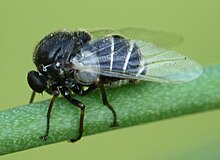Globe flies
| Globe flies | ||||||||||||
|---|---|---|---|---|---|---|---|---|---|---|---|---|

|
||||||||||||
| Systematics | ||||||||||||
|
||||||||||||
| Scientific name | ||||||||||||
| Acroceridae | ||||||||||||
| Leach , 1815 | ||||||||||||
| Subfamilies | ||||||||||||
|
The ball flies (Acroceridae), also known as spider flies, are a family of Diptera (Diptera) and are among the flies (Brachycera). Around 520 species of this group of animals live worldwide, of which only eight are known from Germany. They are medium-sized flies.
features
The ball flies are very stocky and almost spherical in shape. Noticeable are large scales on the sides of the chest (thoracic scales), which cover the hind wings that have been transformed into swinging arches ( holders ). The body is often covered with fine furry hair. Ball flies have a often quite long proboscis which rests in peace under the belly, and is stretched while eating. This often happens when sucking nectar in the almost noiseless shaking flight before flowering.
Behavior and way of life
The globe flies are flower visitors, with a number of very short- nosed species such as Acrocera sanguinea presumably no ingestion occurs. Eggs are laid individually or in smaller clutches, often in exposed places such as the tips of branches. A single female can produce around 1000 eggs, in individual cases even up to 5000.
Larval development
The larvae are parasitoids on spiders . The hatching larvae are tiny and have an adhesive device at the rear end. They can move around like a caterpillar and thus actively reach their hosts (spiders or spider scrubs). Once here, they jump on an approaching spider and penetrate the body through a synovium. After the first molt, the larvae are compact and are connected to the host's fan lung with the posterior stigmas . From this position, the spider is eaten from the inside out, whereby the vital organs are spared. The spider is completely eaten up by the end of the larval stages. Hibernation takes place in the empty host skin, then pupation in the ground. The pupae are strongly curved and in some species have thorns in the chest area.
Fossil evidence
Fossil globe flies are extremely rare. The oldest evidence comes from the Upper Jura of Kazakhstan. The few examples known from Baltic amber ( Eocene , approx. 40 to 50 million years old) and Dominican amber ( Miocene , 15 to 40 million years old) belong to genera that are closely related to recent members of this family living in South Africa and South America are.
Individual evidence
- ↑ http://hbs.bishopmuseum.org/fossilcat/fossacroceridae.html fossil Diptera
- ↑ George O. Poinar Jr .: Life in Amber . Stanford University Press, Stanford (Cal.) 1992, ISBN 0-8047-2001-0 .
- ↑ Wolfgang Weitschat, Wilfried Wichard: Atlas of plants and animals in the Baltic amber. Pfeil-Verlag, Munich 1998, ISBN 3-931516-45-8 .
Web links
literature
- K. Honomichl, H. Bellmann: Biology and ecology of the insects. + CD-Rom. Gustav Fischer Verlag, Stuttgart 1994.
